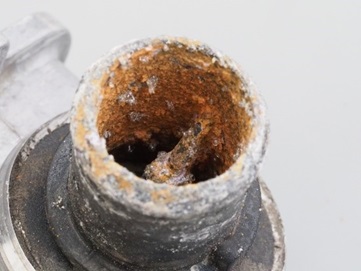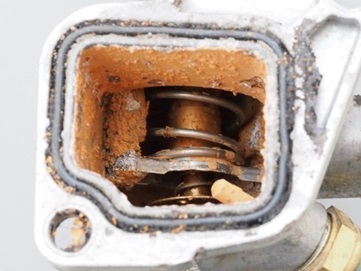The importance of the thermostae cannot be overestimated, as it not only regulates the engine’s operating temperature, preventing the engine from overheating, but also accelerates engine warm-up, improves cold-weather usability and even increases fuel efficiency, Gates reports.
Thermostats come in two main types: most vehicles are equipped with a traditional thermostat, which contains a temperature-sensitive wax element that expands when heated, prompting the piston to move and opening the valve.
In addition, there are map-controlled thermostats with an integrated heating resistor in their wax element.
This resistor is controlled by the engine’s electronics, which can cause the valve to open preventatively, ensuring an even more accurate engine warm-up.
Yet, these two types of thermostats do not display different failure symptoms: the problems you can encounter are the same for both.
Incorrect or old coolant
Coolant needs to be changed at least every five years and coolant types are not interchangeable: every type of coolant has its own specifications and technology.
Mixing coolants using different technologies results in insufficient corrosion protection.
Corrosion in the engine system, in turn, can cause a multitude of problems including surface scaling, damage to the mechanical seals and incorrect coolant system temperature.
If there is any confusion as to which coolant has been used, technicians will need to flush the entire cooling system and renew the coolant.


Stuck thermostat valve
If there are problems with the cooling system, technicians will need to check the thermostat valves.
The thermostat valve is designed to open when the coolant reaches a certain temperature.
lf a thermostat gets stuck in the open position, the frame breaks and the thermostat valve can no longer be fully closed.
This leads to a steady flow of coolant into the radiator, overcooling the engine – a situation that results in poor warm-up and heater performance, increased engine emissions and reduced fuel economy.
lf, by contrast, the wax element has been damaged by corrosion or a mechanical failure, such as a broken thermostat spring, then the thermostat will become stuck in a closed position.
As a result, the flow of coolant into the radiator is blocked, potentially overheating and damaging the engine.
This scenario does a lot of damage to the car and is very expensive to fix, so Gates recommends always changing the thermostat at the same interval as the water pump and timing belt.
Air bubbles
Changing the coolant is a process that needs to be done very carefully – both for traditional and map-controlled thermostats.
Failure to refill the coolant in the right way after performing any cooling system servicing, like changing a thermostat, a coolant hose or a water pump, may cause air to enter the cooling system.
Any time a car leaks coolant, there is a chance of air getting into the cooling system, and the presence of this air may cause overheating problems or a failure of the engine temperature sensor, which subsequently sends the wrong cooling temperature data to the engine control unit.
If the car’s cooling system has bleeder valves, it is easy to solve this problem by opening the bleeder valves until all the air is released and fluid comes out.
Gates power clean flush tool
A lot of cars suffer from improper cooling, either because the coolant has deteriorated over time or because it has become contaminated by damaging deposits (abrasive particles and foreign materials).
If the complete cooling system isn’t properly flushed, dangerous levels of these contaminants can remain inside, which may lead to the premature failure of newly-installed parts.
Gates recommends keeping these problems at bay by flushing the cooling system and removing all debris with its power clean flush tool, which operates solely on clean water and compressed air (so there are no harmful chemicals or solvents involved in the process).
To learn more about Gates, click the ‘more details’ link below.







